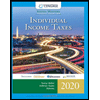
Concept explainers
a.
Introduction: To operate a business, a taxpayer generally chooses between individual trading,
The tax return due date of 2019.
b.
Introduction: To operate a business, a taxpayer generally chooses between individual trading, partnership, and corporation form of entity. The corporations can be of either S Corporation or C Corporation. The taxpayer needs to understand his business requirements properly for the smooth continuance of his business since each form of entity has different tax treatment. After 2018, a new 21 percent rate of tax was introduced for corporations. Corporations must include in ordinary taxable income all net capital gains income during the year for tax purposes and then the income taxed at a regular rate except in certain rare circumstances.
The tax return due date of 2019, in case an extension, is requested.
c.
Introduction: To operate a business, a taxpayer generally chooses between individual trading, partnership, and corporation form of entity. The corporations can be of either S Corporation or C Corporation. The taxpayer needs to understand his business requirements properly for the smooth continuance of his business since each form of entity has different tax treatment. After 2018, a new 21 percent rate of tax was introduced for corporations. Corporations must include in ordinary taxable income all net capital gains income during the year for tax purposes and then the income taxed at a regular rate except in certain rare circumstances.
The tax return due date for paying additional taxes of 2019, in case extension is requested.
Want to see the full answer?
Check out a sample textbook solution
Chapter 11 Solutions
Income Tax Fundamentals 2020
- Can you demonstrate the accurate method for solving this financial accounting question?arrow_forwardCan you help me solve this general accounting problem using the correct accounting process?arrow_forwardI need guidance with this general accounting problem using the right accounting principles.arrow_forward
- Lakeshore Technologies requires $900,000 in assets and will be 100% equity financed. If the Earnings Before Interest and Taxes (EBIT) is $72,000 and the tax rate is 30%, what is the Return on Equity (ROE)?arrow_forwardAt Boston Industries, as of September 30, the company has net sales of $750,000 and a cost of goods available for sale of $620,000. Compute the estimated cost of the ending inventory, assuming the gross profit rate is 35%.arrow_forwardI am looking for a step-by-step explanation of this financial accounting problem with correct standards.arrow_forward
 Individual Income TaxesAccountingISBN:9780357109731Author:HoffmanPublisher:CENGAGE LEARNING - CONSIGNMENT
Individual Income TaxesAccountingISBN:9780357109731Author:HoffmanPublisher:CENGAGE LEARNING - CONSIGNMENT





